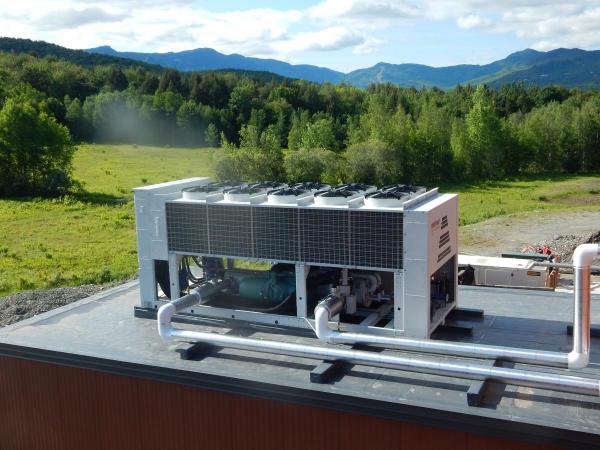Chiller or Condenser: Which One to Choose?
When to Choose a Chiller and When to Choose a Condenser for Your Building or Industrial Process?
In Facility Management, cooling is not just about keeping office spaces comfortable. It is a key pillar for operational efficiency, productivity, and, in many cases, the viability of critical industrial processes.
One of the most crucial decisions when designing or upgrading a cooling system is choosing between a chiller (liquid cooler) and a condenser.
This choice, far from being arbitrary, depends on multiple specific factors related to your building or process.
Understanding the Basics: Chiller vs. Condenser
While both systems share the ultimate goal of cooling, they operate under different principles and scales:
- Chiller (Liquid Cooler): It is a centralized machine that cools a liquid (typically water or a glycol solution). This chilled liquid is pumped through pipes to terminal units (such as air handling units – AHUs, fan coils, or heat exchangers in industrial processes), where it absorbs heat from the environment or the process. Chillers are high-capacity systems and offer great precision in controlling liquid temperature.
- Condenser Unit: It is a key component of a direct expansion (DX) cooling system. It contains the compressor, the condenser coil, and the fan that expels heat to the outside. It works in tandem with an indoor evaporator unit, to which it sends compressed refrigerant. The refrigerant absorbs heat directly from the indoor air at the evaporator unit.
Key Factors for the Decision
The choice between one system or the other is not universal and should be based on a detailed analysis of the following points:
- Capacity and Scale:
- Chiller: Ideal for large thermal loads and large-scale buildings (hospitals, shopping centers, hotels, universities) or industrial processes that require massive and continuous cooling.
- Condenser Unit: Better suited for medium to small thermal loads, such as individual offices, commercial spaces, multifamily residences, or zoned cooling systems (splits, VRF/VRV).
- Type of Application and Precision:
- Chiller: They offer more precise and stable temperature control of the chilled liquid, which is essential for many industrial processes (pharmaceutical, chemical, plastics, food and beverage) and for buildings with very specific comfort requirements.
- Condenser Unit: While efficient, temperature control precision of the air may be slightly lower compared to a well-designed chilled water system, though it is sufficient for most comfort applications.
- Distribution and Flexibility:
- Chiller: Using chilled water allows for more flexible distribution through piping and a wide variety of terminal units (AHUs, fan coils). It facilitates zoning and future system expansion.
- Condenser Unit: It works with refrigerant, which limits pipe length and the number of indoor units per outdoor unit. It is less flexible for long distances or complex distributions.
- Energy Efficiency and Operating Costs:
- Chiller: High-capacity chillers can be extremely energy-efficient, especially when integrated with heat recovery or free cooling systems. They usually have a longer lifespan.
- Condenser Unit: Direct expansion (DX) systems have greatly improved their efficiency (SEER/EER), but at partial or very large loads, a well-managed chiller can be more efficient in the long run. Maintenance costs may be lower for smaller units.
- Initial Cost and Maintenance:
- Chiller: The initial investment is considerably higher due to the complexity of the equipment (chiller, pumps, cooling tower, piping, AHUs). Maintenance is more specialized.
- Condenser Unit: They generally have lower acquisition and installation costs for smaller-scale applications. Maintenance is usually simpler and less expensive for individual units.
- Sustainability and Refrigerants:
- Chiller: Chilled water systems have the advantage that the refrigerant (with high global warming potential – GWP) is confined within the chiller, minimizing the risk of large-scale leaks.
- Condenser Unit: The refrigerant circulates throughout the building, increasing the potential for leaks. However, lower-GWP refrigerants are being developed for these systems.
When to Choose a Chiller?
- When cooling demand is very high and constant.
- In large buildings or complexes with multiple cooling zones and varied needs.
- For industrial processes that require precise and controlled temperatures.
- If high energy efficiency at a large scale is desired and the budget allows for the initial investment.
- When flexibility in cooling distribution and future expansion are priorities.
When to Choose a Condenser Unit?
- For small to medium-sized buildings with moderate cooling demand.
- If opting for direct expansion systems (split, multisplit, VRF/VRV) that provide direct air cooling.
- When the initial budget is tighter and installation needs to be simpler.
- In projects where the distance between the outdoor and indoor units is not excessively long.
- If extreme precision in temperature control is not a critical requirement.
The decision between a chiller and a condenser is strategic and should be approached from a comprehensive Facility Management perspective.
There is no one-size-fits-all solution.
It requires a thorough analysis of your building or process’s specific needs, available budget, energy efficiency goals, expected lifespan, and environmental regulations.
Consulting with cooling and Facility Management experts is essential to ensure a choice that optimizes comfort, productivity, and long-term return on investment.



